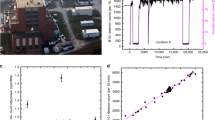Abstract
Pebble bed reactors enable the circulation of pebble fuel elements when the reactors are in operation. This unique design helps to optimize the burnup and power distribution, reduces the excessive reactivity of the reactor, and provides a mean to identify and segregate damaged fuel elements during operation. The movement of the pebbles in the core, or the kinematics of the pebble bed, significantly affect the above features and is not fully understood. We designed and built a detection system that can measure 3-axis acceleration, 3-axis angular velocity, 3-axis rotation angles, and vibration and temperature of multiple pebbles anywhere in the pebble bed. This system uses pebble-shaped detectors that can flow with other pebbles and does not disturb the pebble movement. We used new technologies to enable instant response, precise measurement, and simultaneous collection of data from a large number of detectors. Our tests show that the detection system has a negligible zero drift and the accuracy is better than the designed value. The residence time of the pebbles in a moving pebble bed was also measured using the system.












Similar content being viewed by others
References
US DOE, (US DOE Nuclear Energy Research Advisory Committee and Gen IV International Foru), A technology roadmap for generation IV Nuclear Energy Systems (2002)
M.R. Laufer, Granular dynamics in pebble bed reactor cores. Ph.D. Thesis, University of California, Berkeley (2013)
V.B. Khane, Experimental and computational investigation of flow of pebbles in a pebble bed nuclear reactor. Ph.D. Thesis, Missouri University of Science and Technology (2014)
A.C. Kadak, M.Z. Bazant, Pebble flow experiments for pebble bed reactors. In 2nd international topical meeting on high temperature reactor technology, Beijing, China, Sept. 22–24 (2004)
K.K. Rao, P.R. Nott, S. Sundaresan, An introduction to granular flow (Cambridge University Press, New York (USA), 2008)
Y. Li, J. Wei, A collective dynamics-based method for initial pebble packing in pebble flow simulations. Nucl. Eng. Des. 250, 229–236 (2012). doi:10.1016/j.nucengdes.2012.05.020
J.J. Cogliati, A.M. Ougouag, Pebbles: a computer code for modeling packing, flow and re-circulation of pebbles in a pebble bed reactor. HTR2006: 3rd international topical meeting on high temperature reactor technology, Johannesburg, South Africa, Oct. 1–4 (2006)
C.H. Rycroft, G.S. Grest, J.W. Landry et al., Analysis of granular flow in a pebble-bed nuclear reactor. Phys. Rev. E 74, 021306 (2006). doi:10.1103/PhysRevE.74.021306
Y. Li, Y. Xu, S. Jiang, DEM simulations and experiments of pebble flow with monosized spheres. Powder Technol. 193, 312–318 (2009). doi:10.1016/j.powtec.2009.03.009
G. Liu, Y. Zhang, H. Lu et al., Numerical simulation of particle flow motion in a two-dimensional modular pebble-bed reactor with discrete element method. Science and Technology of Nuclear Installations, Article ID 458190 (2013). doi: 10.1155/2013/458190
Y. Li, W. Ji, Modeling of interactions between liquid coolant and pebble flow in advanced high temperature reactors. Transactions of the American Nuclear Society, Vol. 104, Hollywood, Florida, June 26–30, 201
L.E. Silbert, D. Ertaş, G.S. Grest et al., Granular flow down an inclined plane: Bagnold scaling and rheology. Phys. Rev. E 64, 051302 (2001). doi:10.1103/PhysRevE.64.051302
X. Yang, W. Hu, S. Jiang, Experimental investigation on feasibility of two-region-designed pebble-bed high-temperature gas-cooled reactor. J. Nucl. Sci. Technol. 46, 374–381 (2009). doi:10.1080/18811248.2007.9711543
S.Y. Jiang, X.T. Yang, Z.W. Tang et al., Experimental and numerical validation of a two-region-designed pebble bed reactor with dynamic core. Nucl. Eng. Des. 246, 277–285 (2012). doi:10.1016/j.nucengdes.2012.02.005
G.J Auwerda, J.L Kloosterman, A J M. Winkelman et al., Comparison of experiments and calculations of void fraction distributions in randomly stacked pebble beds. PHYSOR 2010-Advances in reactor physics to power the nuclear renaissance, Pittsburgh, Pennsylvania, USA, May 9–14, (2010)
G.J. Auwerda, J.L. Kloosterman, D. Lathouwers et al., Macroscopic and microscopic packing properties of experimental and computational pebble beds. Nucl. Technol. 183(3), 272–286 (2013)
A. Ooms, Pebble flow in a high temperature reactor. Master Thesis, Delft University of Technology, 2008
M.M. Radmanesh, Radio frequency and microwave electronics illustrated (Prentice Hall, New Jersey, 2001)
R.H. Zhang, H.G. Jia, T. Chen et al., Attitude solution for strapdown inertial navigation system based on quaternion algorithm. Opt Precis Eng 16(10), 1963–1970 (2008). (in Chinese)
Y.Y. Qin, Inertial navigation[M] (Science Press, Beijing (China), 2014)
Y. Yu, H. Saxén, Discrete element method simulation of properties of a 3D conical hopper with mono-sized spheres. Adv. Powder Technol. 22, 324–331 (2011). doi:10.1016/j.apt.2010.04.003
C.H. Rycroft, A. Dehbi, T. Lind et al., Granular flow in pebble-bed nuclear reactors: scaling, dust generation, and stress. Nucl. Eng. Des. 265, 69–84 (2013). doi:10.1016/j.nucengdes.2013.07.010
X.W. Luo, S.Y. Yu, Z.S. Zhang et al., Estimation of graphite dust quantity and size distribution of graphite particle in HTR-10. Nucl. Power Eng. 26(2), 203–208 (2005). (in Chinese)
Author information
Authors and Affiliations
Corresponding author
Additional information
Supported by the “Strategic Priority Research Program” of the Chinese Academy of Sciences (Grant No. XDA02050100).
Rights and permissions
About this article
Cite this article
Zhao, Y., Qu, SX., Zhu, XW. et al. Development of an innovative detection system for pebble bed kinematic studies. NUCL SCI TECH 27, 31 (2016). https://doi.org/10.1007/s41365-016-0048-z
Received:
Revised:
Accepted:
Published:
DOI: https://doi.org/10.1007/s41365-016-0048-z




